What is Opqz file extension
.Opqz file extension is a file extension that is associated with the newest version of widespread ransomware called STOP (Djvu). This malware was discovered by the security researcher recently. Upon infecting a computer, it encrypts files on the computer, renames the affected files, adding .Opqz extension at the end of their filenames, and demands a ransom for a key that will allow the computer owner to decrypt the files. Fortunately, there is a free Opqz Decrypt Tool called ‘STOP (Djvu) Decryptor’ that allows in some cases to decrypt encrypted files. Scroll through this article below to learn more about this decrypt tool and how to use it, as well as alternative ways to recover the contents of encrypted files.
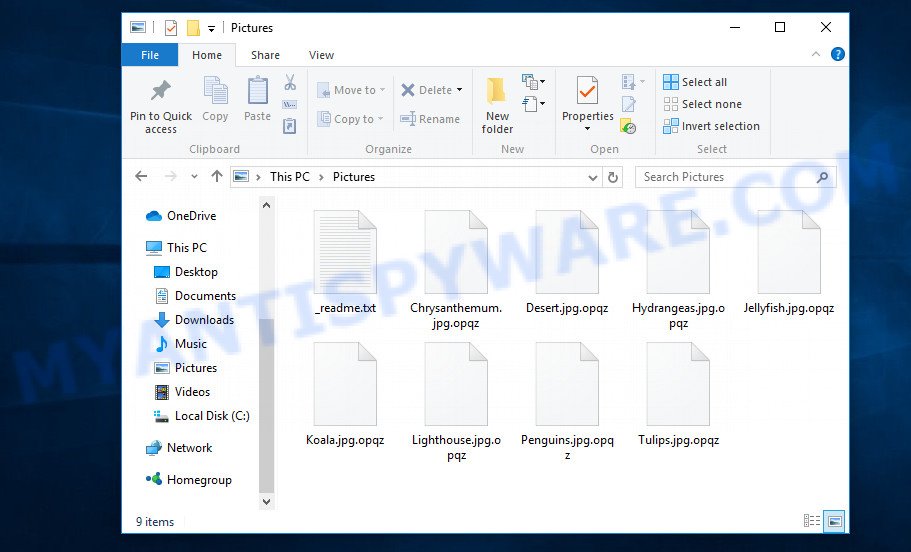
Screenshot of files encrypted by Opqz ransomware virus (‘.opqz’ file extension)
What is Opqz ransomware virus
First discovered recently, Opqz ransomware is the newest version of STOP ransomware. Ransomware is a type of malware that encrypts files on the victim’s computer and demands a ransom payment to restore access to the contents of these files. Opqz targets users running Microsoft Windows. In most cases, this malware requires user actions in order to be installed on the computer. Typically, criminals use various tricks, for example, disguising the malicious software as a freeware, cracks, activators and key generators, so that victims download and run Opqz virus on their computer.
Upon infecting a computer, it performs the following steps as part of its preparation for encrypting files: creates a folder in the Windows system directory and copies itself to it; adds itself to the list of programs that start up every time the computer is turned on; collects information about the victim’s computer; establishes connection with its command server (C&C).
If Opqz ransomware was able to establish a connection with the C&C server, then it sends some information about the victim’s computer to the server, and the server returns a key to it that must be used to encrypt files. Such a key is called ‘online key’ and it is unique for each case of ransomware infection. If a connection to the C&C server has not been established, the ransomware uses a fixed key (so called ‘offline key’), which is unique for each version of STOP (djvu) ransomware, but the same for each case of Opqz infection.
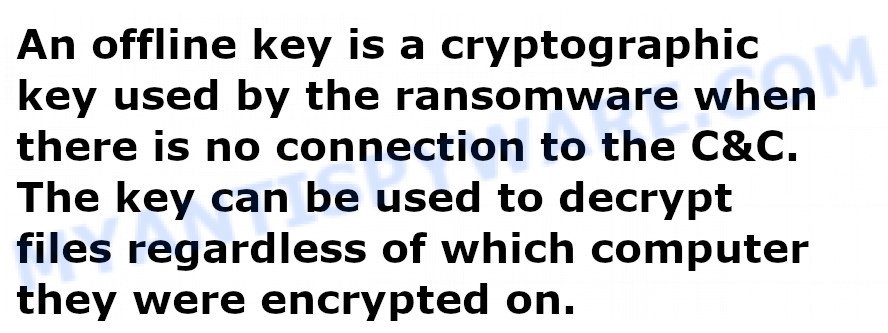
Having determined which key to use, Opqz ransomware virus goes to the main thing – it starts the file encryption process. Of course, it does not encrypt absolutely all files, since encryption of the Windows system files will cause the computer to stop working. Therefore, the ransomware does not encrypt files located in the system directory of Windows, as well as files with the following extensions: ‘.sys, .dll, .lnk, .ini, .bat’. In addition, Opqz virus does not encrypt files named ‘_readme.txt’. All other files will become the target of the malware, for example, the following file types can be encrypted:
.sb, .wp4, .xlk, .x, .wp7, .xlsm, .sid, .x3f, .zdc, .vfs0, .txt, .menu, .x3f, .2bp, .png, .jpg, .eps, .vtf, .hkdb, .pfx, .lbf, .zip, .wsc, .pak, .sidd, .bc7, .xxx, .itdb, .webdoc, .rofl, .docx, .sum, .pdf, .pst, .desc, .xll, .iwi, .wgz, .der, .m3u, .3ds, .itm, .jpeg, .zif, .snx, .xlsm, .srf, .dcr, .ysp, .wp5, .mpqge, .wmv, .wpd, .r3d, .odm, .wbk, .srw, .fpk, .xlgc, .rtf, .wbm, .ppt, .pdd, .w3x, .odc, .kdc, .pkpass, .psd, .xld, .wbd, .svg, .bkf, .litemod, .crt, .ptx, .fos, .p7c, .7z, .ibank, .z3d, .wsd, .wn, .apk, .css, .mddata, .1, .iwd, .wpt, .wp6, .xx, .re4, .mcmeta, .wbc, .wpe, .hvpl, .psk, .erf, .forge, .yal, .icxs, .sql, .indd, .xmind, .pptx, .xar, .dwg, .doc, .esm, .nrw, .tor, .yml, .gdb, .mdbackup, .hplg, .sis, .xbplate, .xwp, .arw, .fsh, .pptm, .ztmp, .vpk, .wb2, .xyw, .dmp, .qdf, .docm, .sie, .wsh, .asset, .wmd, .wpl, .cas, .ncf, .odp, .mov, .odt, .xlsx, .wmo, .mp4, .xpm, .rgss3a, .rim, .raw, .bkp, .xdl, .wdp, .map, .xy3, .db0, .mlx, .wotreplay, .vdf, .bay, .arch00, .zabw, .rwl, .vcf, .ws, .crw, .sr2, .zdb, .wps, .pef, .syncdb, .bc6, .wpw, .hkx, .js, .slm, .lvl, .wbmp, .ltx, .xlsb, .t13, .rb, .dbf, .wire, .sidn, .sav, .cfr, .xls, .wpa, .wri, .epk, .wmv, .xml, .das, .rar, .layout, .p12, .wpb, .bar, .tax, .webp, .upk, .py, .csv, .itl, .wpg, .orf, .wcf, .zi, .qic, .gho, .big, .x3d, .xmmap
All encrypted files become completely useless, their contents cannot be read in any way. To clearly show that the files are encrypted, the ransomware virus appends a new ‘.opqz’ extension at the end of the filename of each encrypted file. This means the following: if the file had the name ‘photo-image.jpg’, then after it has been encrypted, it will be called ‘photo-image.jpg.opqz’. In all directories where there are encrypted files, Opqz virus drops a file named ‘_readme.txt’
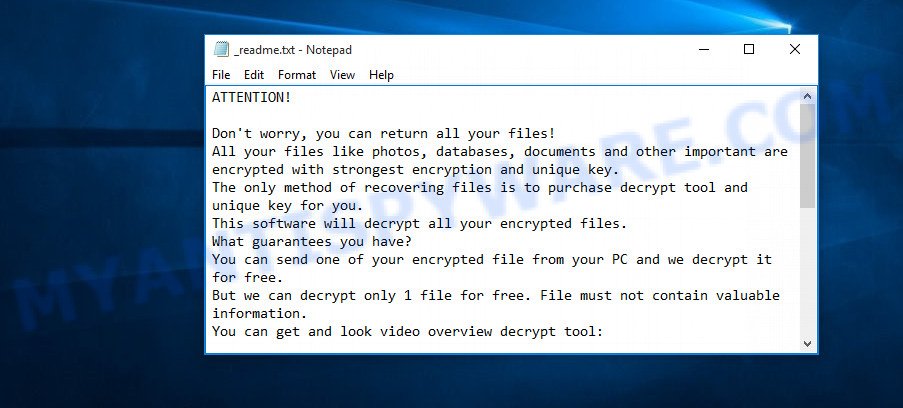
Screenshot of the contents of ‘_readme.txt’ file (Opqz ransom demand message)
This file contains text written by Opqz authors. In this message, the criminals report that the user’s files were encrypted and the only way to get them back is to buy a key and a decryptor. Attackers give the victim 72 hours. At this time, the key will cost $490, after 72 hours the ransom will increase to $980. The message also contains the contact information of the criminals, using which the victim can check the ability of the attackers to decrypt .opqz files, as well as find out where to send the ransom.
Threat Summary
| Name | Opqz |
| Type | Crypto malware, File locker, Filecoder, Ransomware, Crypto virus |
| Encrypted files extension | .opqz |
| Ransom note | _readme.txt |
| Contact | helpdatarestore@firemail.cc, helpmanager@mail.ch |
| Ransom amount | $490/$980 in Bitcoins |
| Detection Names | Trojan.Ransom.Stop, Win32:CoinminerX-gen [Trj], Trojan.GenericKD.33566550, Trojan.DownLoader33.21716, Win32/Kryptik.HCGQ, Trojan.TR/AD.InstaBot.nelvv, W32/Kryptik.HCGQ!tr, Trojan.Win32.Crypt, Trojan-Ransom.Win32.Stop.lk, BehavesLike.Win32.Vundo.bc, Ransom.Stop!8.10810 (CLOUD) |
| Symptoms | Unable to open files. Your personal files have a wrong name, suffix or extension, or don’t look right when you open them. Your file directories contain a ‘ransom note’ file that is usually a .html, .jpg or .txt file. Ransom note in a pop-up window with cybercriminal’s ransom demand and instructions. |
| Distribution ways | Phishing emails that look like they come from a reliable source. Drive-by downloads from a compromised web page. Social media posts (they can be used to trick users to download malicious software with a built-in ransomware downloader or click a misleading link). USB key and other removable media. |
| Removal | Opqz virus removal guide |
| Decryption | Free Opqz Decrypt Tool |
In file ‘_readme.txt’, criminals scare victims by saying that encrypted files cannot be decrypted without paying a ransom. And unfortunately this is true, the contents of the files cannot be read while the files are encrypted, and a key and decryptor are needed to decrypt them.
Fortunately, Emsisoft created a decryptor (Opqz Decrypt Tool). This decryptor can help each victim to decrypt .opqz files for free. But in addition to the decryptor, the key is still necessary. As we reported above, the virus can use two types of keys. An offline key can be determined by researchers, but only criminals have an online key. Thus, files encrypted with so called ‘offline key’ can be decrypted. And all files that have been encrypted with so called ‘online key’ cannot yet be decrypted. In this case, the alternative methods listed below in this article can be used to recover the contents of these files.
How to remove Opqz ransomware and Descrypt (restore) .opqz files
If your documents, the files of your friends or colleagues, were encrypted with Opqz ransomware virus, then you need to follow a few steps listed below that will allow you to find and remove Opqz, as well as decrypt or restore the encrypted files. It is very important to read the entire instruction manual carefully and make sure to understand it all. We advise you not to skip any steps, each of the steps is very important and must be completed by you. In order not to get confused and not miss an important point in the instructions, we recommend that you print this article or open it on your smartphone.
How to remove Opqz ransomware virus
The presence of encrypted files on the computer means one thing – the computer has become the victim of ransomware attack. Therefore, regardless of the fact that it seems to you that Opqz ransomware virus is no longer on the computer, you should check the computer with malware removal utilities. Do not try to skip this step and immediately begin to decrypt your files. By doing so, you can kill the ability to decrypt files or block alternative methods of data recovery.
In order to scan the system for ransomware and other malware, we recommend using free malware removal tools. These utilities have all the necessary functions, they can find ransomware and its components, remove Opqz virus from your computer for free. Below we provide a list of the best malware removal utilities, with brief instructions describing the process of identifying and removing the ransomware.
Use Zemana Anti-Malware to remove Opqz ransomware
Thinking about remove Opqz ransomware virus from your computer for free? Then pay attention to Zemana AntiMalware. This is a well-known tool, originally created just to search for and remove malicious software, trojans and worms. But by now it has seriously changed and can not only rid you of malware, but also protect your machine from crypto malware, malicious software and worms, as well as identify and uninstall common viruses and trojans.

- Visit the page linked below to download the latest version of Zemana AntiMalware for MS Windows. Save it on your Microsoft Windows desktop or in any other place.
Zemana AntiMalware
165491 downloads
Author: Zemana Ltd
Category: Security tools
Update: July 16, 2019
- When downloading is complete, close all software and windows on your system. Open a folder in which you saved it. Double-click on the icon that’s named Zemana.AntiMalware.Setup.
- Further, click Next button and follow the prompts.
- Once install is done, press the “Scan” button to perform a system scan for Opqz ransomware virus, other malicious software, worms and trojans. Depending on your personal computer, the scan may take anywhere from a few minutes to close to an hour. During the scan Zemana Anti Malware will scan for threats exist on your personal computer.
- Once the scan is done, it will display the Scan Results. Make sure all threats have ‘checkmark’ and click “Next”. After finished, you can be prompted to reboot your machine.
Remove Opqz virus with MalwareBytes Anti Malware
We advise using the MalwareBytes Anti Malware (MBAM) which are completely clean your machine of ransomware. This free tool is an advanced malware removal application created by (c) Malwarebytes lab. This program uses the world’s most popular anti malware technology. It is able to help you remove crypto malware, PUPs, malware, adware, toolbars, and other security threats from your personal computer for free.
First, click the link below, then click the ‘Download’ button in order to download the latest version of MalwareBytes.
327714 downloads
Author: Malwarebytes
Category: Security tools
Update: April 15, 2020
Once downloading is finished, close all windows on your personal computer. Further, start the file named mb3-setup. If the “User Account Control” prompt pops up as shown on the image below, click the “Yes” button.

It will show the “Setup wizard” which will help you install MalwareBytes Free on the system. Follow the prompts and don’t make any changes to default settings.
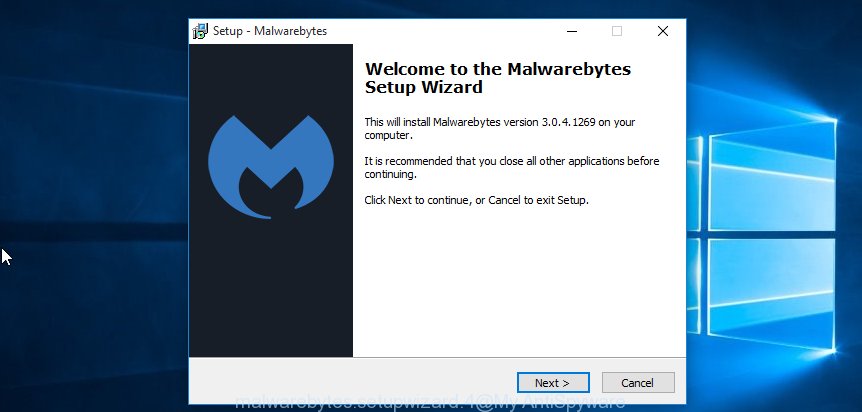
Once installation is complete successfully, click Finish button. Then MalwareBytes Anti-Malware will automatically start and you can see its main window as shown in the figure below.
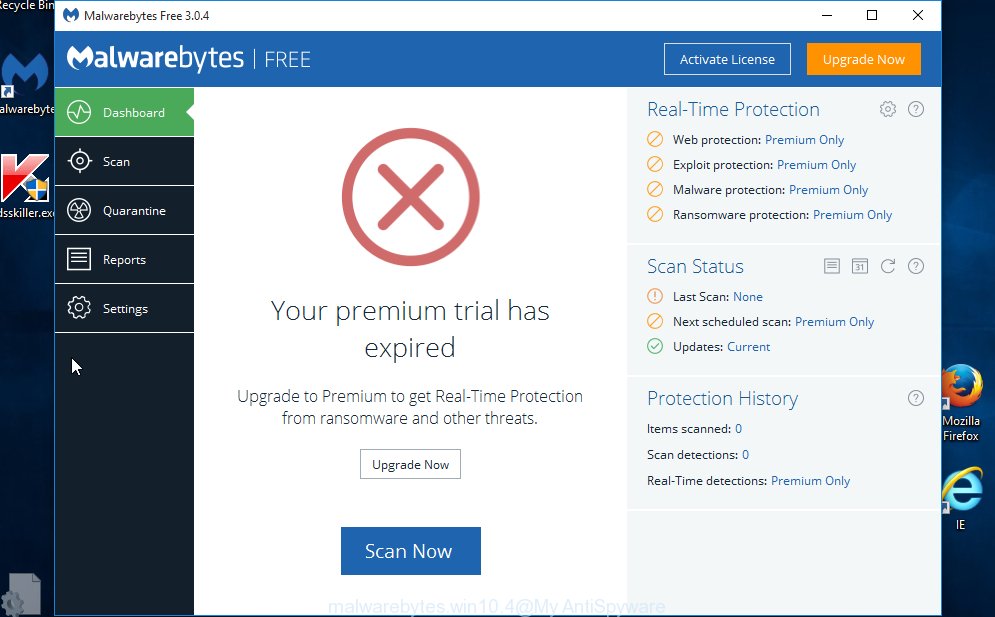
Next, click the “Scan Now” button to perform a system scan for Opqz crypto virus and other security threats. A system scan can take anywhere from 5 to 30 minutes, depending on your machine. While the MalwareBytes Anti Malware (MBAM) is scanning, you can see how many objects it has identified either as being malicious software.
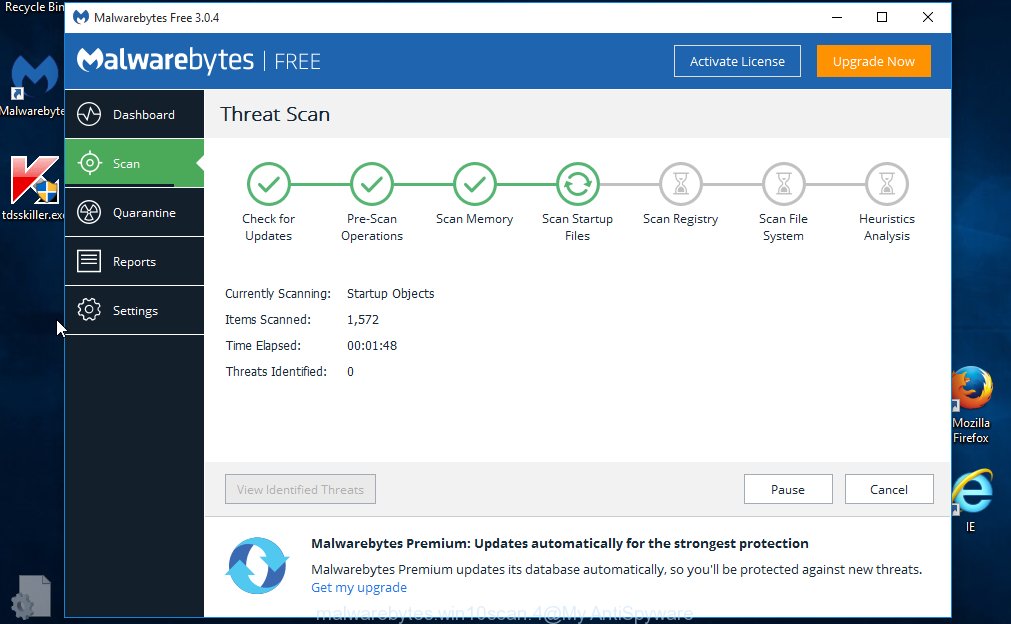
As the scanning ends, MalwareBytes AntiMalware will display a list of all threats found by the scan. Next, you need to press “Quarantine Selected” button.
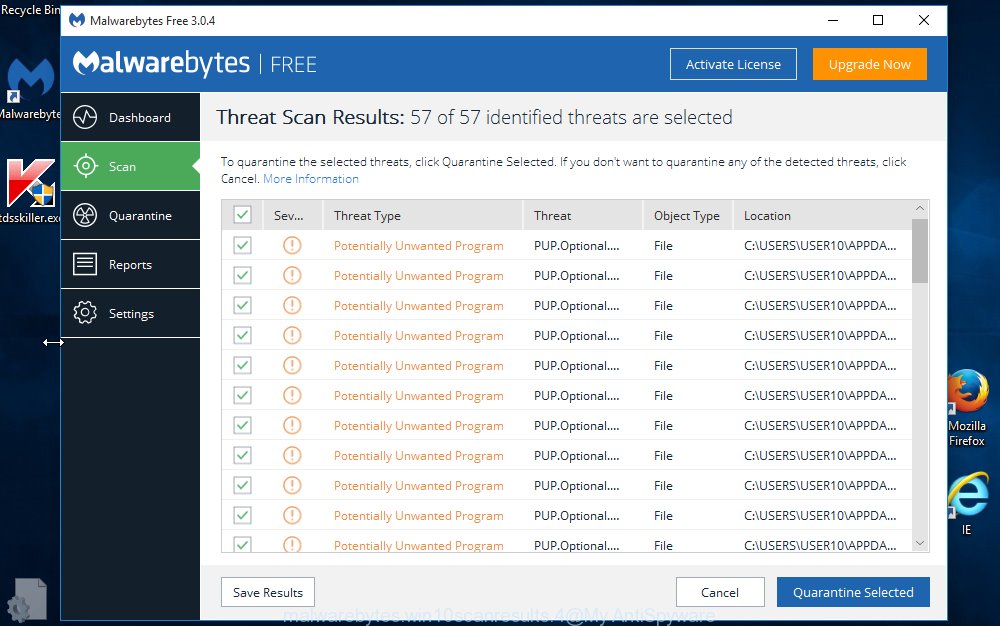
The MalwareBytes Anti Malware (MBAM) will delete Opqz ransomware, other kinds of potential threats such as malicious software and trojans. Once disinfection is finished, you can be prompted to restart your PC. We suggest you look at the following video, which completely explains the procedure of using the MalwareBytes to delete hijackers, adware and other malicious software.
Remove Opqz from PC with KVRT
Kaspersky virus removal tool (KVRT) is a free removal utility that can scan your computer for a wide range of security threats such as Opqz crypto malware, adware, spyware, potentially unwanted applications, trojans, worms as well as other malware. It will perform a deep scan of the machine including hard drives and Windows registry. Once a malicious software is found, it will allow you to uninstall all found threats from your system by a simple click.
Download Kaspersky virus removal tool (KVRT) by clicking on the following link.
129488 downloads
Author: Kaspersky® lab
Category: Security tools
Update: March 5, 2018
Once the download is done, double-click on the KVRT icon. Once initialization process is complete, you’ll see the KVRT screen as displayed on the image below.

Click Change Parameters and set a check near all your drives. Press OK to close the Parameters window. Next click Start scan button . Kaspersky virus removal tool utility will start scanning the whole computer to find out Opqz ransomware virus and other malicious software. A system scan can take anywhere from 5 to 30 minutes, depending on your system. While the KVRT application is scanning, you can see count of objects it has identified as threat.

Once that process is complete, Kaspersky virus removal tool will prepare a list of unwanted programs and crypto malware as on the image below.

Review the scan results and then click on Continue to begin a cleaning task.
How to decrypt .opqz files
Files with the extension ‘.opqz’ are encrypted files. The virus uses a long key and a strong encryption algorithm, so it is impossible to decrypt files without a key and decryptor. Criminals demand a ransom for the key and the decryptor. Of course, even paying a ransom, there is no guarantee that victims will receive the required key and decryptor. Fortunately, a team of experts from Emsisoft created a decryptor that allows everyone to decrypt .opqz files for free.
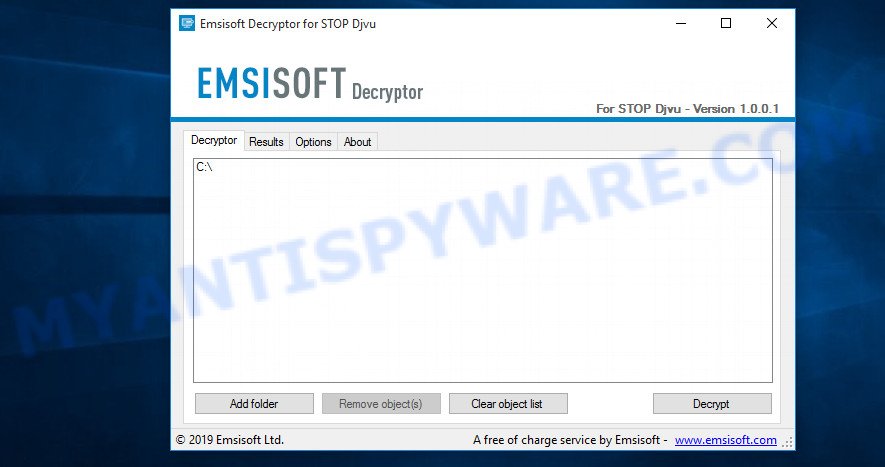
Free Opqz File Decrypt tool also known as STOP Djvu decryptor
To decrypt .opqz files, use “Opqz File Decrypt tool”:
- Go to the following link to download Opqz File Decrypt tool.
STOP Djvu decryptor - Scroll down to ‘New Djvu ransomware’ section.
- Click the download link and save the ‘decrypt_STOPDjvu.exe’ file to your desktop.
- Run decrypt_STOPDjvu.exe, read the license terms and instructions.
- On the ‘Decryptor’ tab, using the ‘Add a folder’ button, add the directory or disk where the encrypted files are located.
- Click the ‘Decrypt’ button.
As we said earlier, Opqz ransomware virus can use two types of keys: an online key and an offline key. The online key is unique to each victim and only the creators of the virus have it. Therefore, files encrypted with an online key cannot yet be decrypted. The offline key is the same for all computers, and once it is determined by security researchers, it can be used to decrypt files regardless of which computer they were encrypted on. Therefore, at the moment, the decryptor can only decrypt .opqz files that were encrypted with an offline key.
This does not mean that if your files are encrypted with an online key, then their contents are lost forever. Fortunately, there are several ways to recover encrypted files. These methods do not involve the use of decryption and therefore can be used in any case, regardless of what type of key the files were encrypted.
How to find out which key was used to encrypt files
Below we show two ways to help you determine what type of key was used to encrypt your files. This is very important, since the type of key determines whether it is possible to decrypt .opqz files. We recommend using the second method, as it is more accurate.
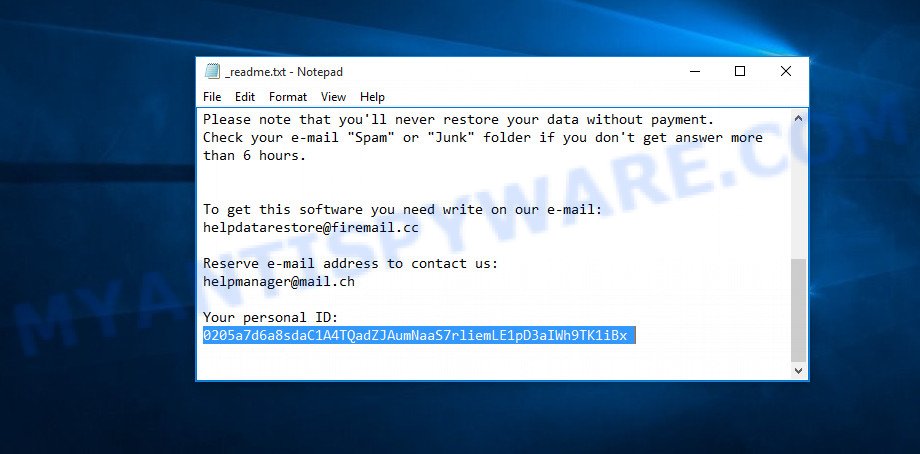
Personal ID is highlighted here
Find out the type of key using ‘_readme.txt’ file
- Open the ransom demand message (‘_readme.txt’ file).
- Scroll down to the end of the file.
- There you will see a line with the text ‘Your personal ID’.
- Below is a line of characters – this is your personal id.
Find out the type of key using ‘PersonalID.txt’ file
- Open disk C.
- Open directory ‘SystemID’.
- Open file named ‘PersonalID.txt’. This file lists ‘Personal ID’s that match the keys that the Opqz ransomware used to encrypt files.
The ‘Personal ID’ is not a key, it is an identifier related to a key that was used to encrypt files. If the ID ends with ‘t1’, then the files are encrypted with an offline key. If the ID does not end with ‘t1’, Opqz ransomware virus used an online key. If you could not figure out how to determine which key was used to encrypt files, then we can help. Just write a request here or in the comments below.
What to do if the Opqz File Decrypt tool says “No key for New Variant offline ID”
If during decryption of .opqz files the decryptor reports No key for New Variant offline ID, then this means the following: your files are encrypted with an ‘offline key’, but the key itself has not yet been found by security researchers, in this case, you need to be patient and wait a while, in addition, you can also use alternative ways for recovering encrypted data. It is impossible to say exactly when the ‘offline key’ will be determined. Sometimes it takes several days, sometimes more. We recommend that you try to decrypt .opqz files from time to time. You can also use alternative ways listed below for recovering encrypted data.
What to do if the Opqz File Decrypt tool says “No key for New Variant online ID”
If, when you try to decrypt .opqz files, the decryptor reports No key for New Variant online ID, then this means that your files are encrypted with an ‘online key’ and their decryption is impossible, since only the Opqz authors have the key necessary for decryption. In this case, you need to use alternative methods listed below to restore the contents of encrypted files.
How to restore .opqz files
If the Opqz File Decrypt tool cannot decrypt the encrypted files or your data is encrypted with an online key, then there is no need to despair. Fortunately, there are several alternative methods that can allow everyone to recover the contents of encrypted files. Each of these methods does not involve the use of special knowledge and paid programs and can be performed by everyone. We have prepared an instruction with illustrations, which describes in detail the process of data recovery. Before you begin data recovery, if you have not completed step 1, then go back. You must be 100% sure that Opqz ransomware virus is completely removed. We recommend using free malware removal tools.
Use ShadowExplorer to restore .opqz files
The first and very simple way to restore encrypted files to the state in which they were before encryption is to restore files from their Shadow Copies. The Shadow Volume Copies are copies of files and folders that Windows automatically saved as part of system protection. This feature is fantastic at rescuing personal files that were locked by Opqz ransomware. The guide below will give you all the details.
Visit the following page to download the latest version of ShadowExplorer for Windows. Save it directly to your Microsoft Windows Desktop.
440037 downloads
Author: ShadowExplorer.com
Category: Security tools
Update: September 15, 2019
Once the downloading process is complete, open a directory in which you saved it. Right click to ShadowExplorer-0.9-portable and select Extract all. Follow the prompts. Next please open the ShadowExplorerPortable folder like below.

Double click ShadowExplorerPortable to launch it. You will see the a window like below.
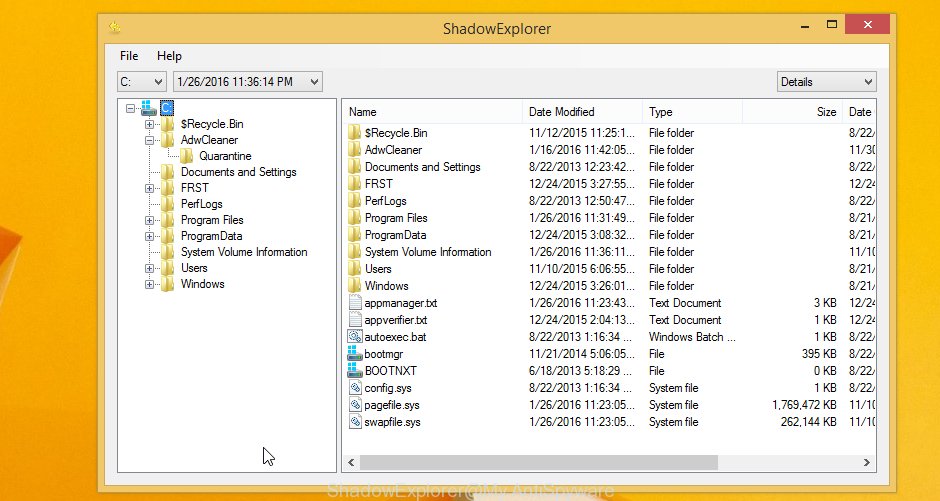
In top left corner, select a Drive where encrypted photos, documents and music are stored and a latest restore point as shown below (1 – drive, 2 – restore point).

On right panel look for a file that you wish to restore, right click to it and select Export as shown in the following example.

Run PhotoRec to recover .opqz files
Another way to recover encrypted files is to use data recovery programs. There are many such programs, but most of them are paid. We recommend using a program called PhotoRec. It has all the necessary functions and is completely free.
Download PhotoRec from the link below.
When the downloading process is done, open a directory in which you saved it. Right click to testdisk-7.0.win and choose Extract all. Follow the prompts. Next please open the testdisk-7.0 folder as shown in the figure below.

Double click on qphotorec_win to run PhotoRec for Microsoft Windows. It’ll open a screen like below.

Choose a drive to recover as displayed below.

You will see a list of available partitions. Choose a partition that holds encrypted files as on the image below.

Click File Formats button and specify file types to recover. You can to enable or disable the recovery of certain file types. When this is done, click OK button.

Next, press Browse button to select where recovered personal files should be written, then click Search.

Count of recovered files is updated in real time. All restored photos, documents and music are written in a folder that you have selected on the previous step. You can to access the files even if the recovery process is not finished.
When the restore is finished, click on Quit button. Next, open the directory where restored photos, documents and music are stored. You will see a contents as shown in the figure below.

All restored personal files are written in recup_dir.1, recup_dir.2 … sub-directories. If you’re looking for a specific file, then you can to sort your recovered files by extension and/or date/time.
How to protect your system from Opqz ransomware virus
Most antivirus software already have built-in protection system against the crypto virus. Therefore, if your computer does not have an antivirus program, make sure you install it. As an extra protection, run the HitmanPro.Alert. HitmanPro.Alert is a small security tool. It can check the system integrity and alerts you when critical system functions are affected by malware. HitmanPro.Alert can detect, remove, and reverse ransomware effects.
First, visit the page linked below, then press the ‘Download’ button in order to download the latest version of HitmanPro Alert.
Once the download is finished, open the file location. You will see an icon like below.

Double click the HitmanPro.Alert desktop icon. After the tool is started, you will be displayed a window where you can choose a level of protection, as shown below.
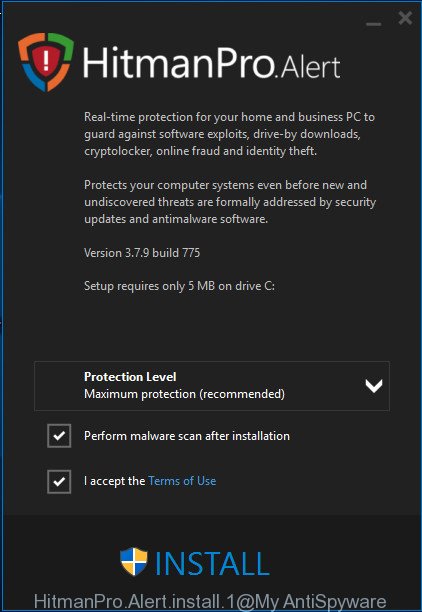
Now press the Install button to activate the protection.
To sum up
This article was created to help all victims of Opqz ransomware virus. We tried to give answers to the following questions: how to remove ransomware; is there a Free Opqz File Decrypt tool; how to decrypt .opqz files; how to recover files, if the decryptor does not help; what is an online key and what is an offline key. We hope that the information presented in this article has helped you.
If you have questions, then write to us, leaving a comment below. If you need more help with Opqz ransomware related issues, go to here.





















Thank you so much.
I’ve been close to tears all day and was close to giving up when I saw your post.
It was just 2 hours ago.
God bless you.
Thank you so much for such a great information. I am the victim of opqz on 28/3/2020. There is no antivirus tool in my pc. My query is, if I purchase a new
antivirus tool and install today, will it remove the opqz and decrypt all my files.
i cant decrypt m data plz help
shadow Explorer is showing file in drive C only. While it is unable to open D, E & F … So it is useless … unfortunately …
@sachin Please tell how u encrypt ur files
Any idea how can we recover files from D, E and so on?
The ShadowExplorer only shows C.
Thanks.
This means that the Volume Shadow Copy (also known as Volume Snapshot Service or VSS) service was only enabled for drive C.
sachin which antivirus tools purchase please send them
i am also a victim by yestesbay.If anybody got decrypted plz tell me and sent by a mail joemonbenny AT gmail DOT com
I am also a victim and was infected near 27 march but noticed only on 30 and if anyone finds the fix please tell me.
Also shadowexplorer didn’t work even for files in [C:] so i think it is the new variety of opqz ransomware that it talked about in some other sites.
The text file on my pc indicates that it has online key and if the decrypter still work on those type ovif files please help.Contact me at —>”nflratnesh at gmail dot com”
It looks like opqz ransomware deleted all the shadow copies. Therefore, ShadowExplorer could not help you. Try to use PhotoRec.
How to decrypt .OPQZ online files?
If .OPQZ files are encrypted with an online key, then at the moment there is no way to decrypt them. The only way for you to recover the contents of encrypted files is to use data recovery tools. You can learn more about this in the next article: How to recover encrypted files.